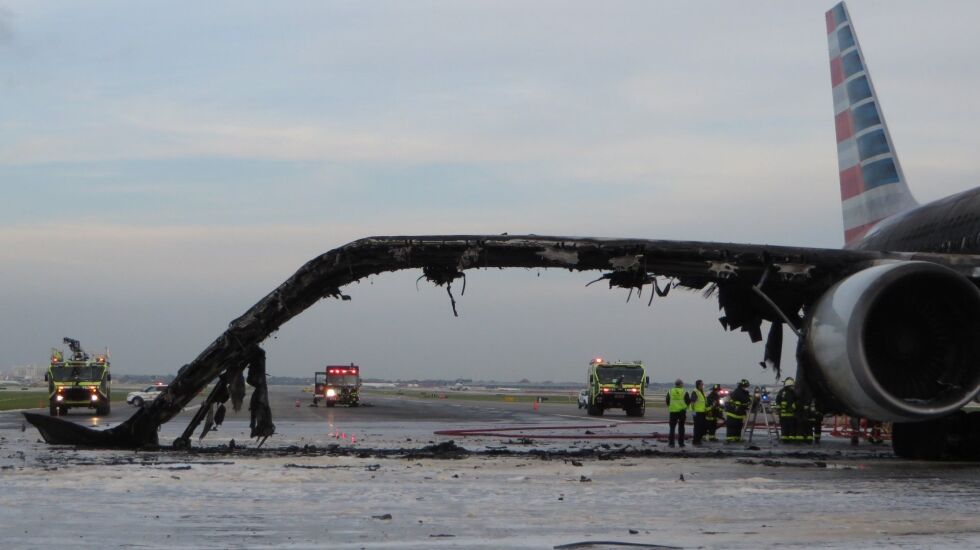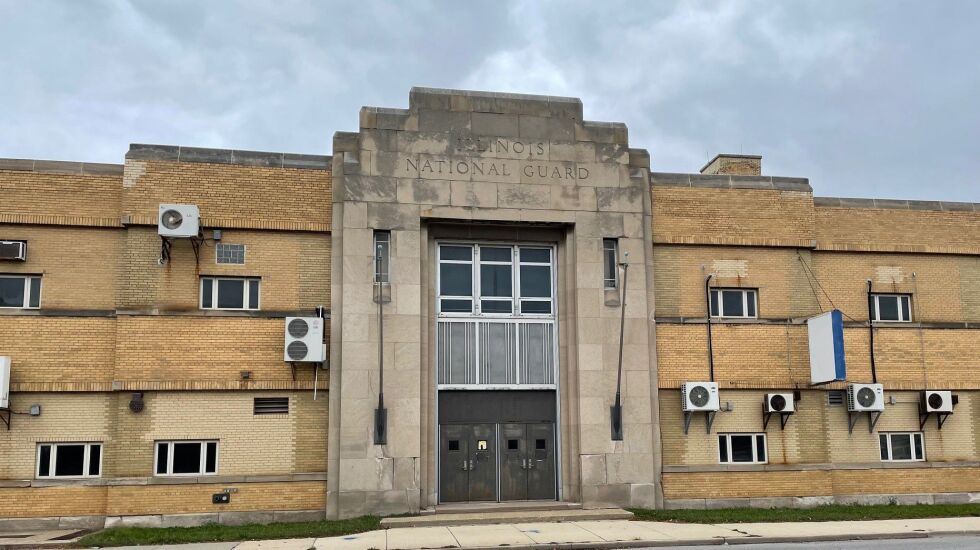
When an American Airlines jetliner caught fire on an O’Hare Airport runway in October 2016, firefighters rushed to the scene.
Within three minutes, they’d blanketed the flames with a suffocating foam, a product used at airports for half a century.
Known as AFFF, it has been used by Chicago and military firefighters because it can extinguish intense jet fuel fires.
The foam, now being phased out, also contains toxic substances known as forever chemicals that have been linked to cancers, liver damage, low birth weights, high cholesterol and other health threats.
Those chemicals contaminated groundwater beneath city of Chicago-run O’Hare and Midway airports, military investigators have found. As part of a Department of Defense-initiated cleanup nationwide, they plan another round of testing as soon as next year. The department estimates that national cleanup costs will come to $39 billion.
Little has been made public about the extensive use of the firefighting foam in Chicago, but the Defense Department is examining the spread of the chemicals from the city’s two airports, where military stations once operated.
The chemicals — per- and polyfluoroalkyl substances, PFAS for short — contaminated groundwater at the airports, investigators found, though the extent of the spread isn’t clear.
“PFAS was the go-to firefighting chemical on airfields — both civilian and military across this country for the longest time,” U.S. Sen. Tammy Duckworth, D-Illinois, says. “We had no idea what the consequences of PFAS exposure was.”
Duckworth, an Army veteran who trained at Midway, is among lawmakers pushing for the cleanup. She’s also pressing for alternatives to the foams, which still are used at military sites and airports, though federal officials advise that their use be limited to emergencies.

Over decades, PFAS were spread at the airports through foam that spilled or was used for fires and training exercises. The military required its use. And large airports, such as O’Hare and Midway, made the product a standard for dousing petroleum-based fires. Tens of thousands of gallons of the foam have been stored at the two Chicago airports.
Firefighting foam isn’t the only product made with PFAS. Thousands of consumer products — including nonstick pans, waterproof clothing, pizza boxes, microwave popcorn bags and dental floss — can contain the chemicals, which have been used since the 1940s. Nearly 15,000 chemicals are in the class of compounds known as PFAS. It’s estimated that almost everyone in the United States has some level of PFAS in their bodies.
In addition to the Chicago Fire Department stations at O’Hare and Midway, the military had ample supplies on site.
At O’Hare, the foam was used at an Air Force Reserve station from 1970 until it was closed in 1999. There are 11 locations at the former training site that need further investigation, according to an Air Force report in 2020 that says there were multiple spills in the 1990s at different locations.
At the base fire station, tanks holding thousands of gallons of foam were stored.
At Midway, the Illinois Army National Guard trained around an armory building that’s still standing on 63rd Street near Central Avenue. A Chicago Fire Department station is just to the east on 63rd.
The Army National Guard moved its base to Kankakee in 2017 after operating at Midway for much of the last century. A National Guard report, also completed in 2020, said it stored the PFAS foam but didn’t use it for training or on fires.
But possible releases of PFAS foam from spills in and around the armory would likely drain into the sewers that led to a water-treatment plant in Cicero, the report said.
Both military branches ruled out any immediate threat to drinking water because Chicago and most suburbs surrounding the airports depend on Lake Michigan water piped directly to homes.
The Air Force did an initial survey of suburban wells in the area within a mile around the airport and found no drinking water wells were immediately threatened.
Still, experts say the chemicals could now be in the ground beneath homes, surrounding areas and in the sewer system. Even after contaminated water is treated, the chemicals remain.
“Once it gets into groundwater and discharged, it’s there forever,” says Erik Olson, a senior strategist with the Natural Resources Defense Council, an environmental advocacy group.
PFAS were branded forever chemicals because they don’t break down in the environment. Other than in small-scale lab experiments, nothing has been shown to destroy the chemicals, including processing at water-treatment plants.
The Metropolitan Water Reclamation District of Greater Chicago, which operates the Stickney water-treatment plant in Cicero, also distributes biosolids, or sludge, to mix in topsoil. It says it follows federal environmental guidelines that deem the material safe for growing produce.
Aware of the concern over PFAS, water reclamation district officials say they are awaiting federal environmental guidelines regarding testing for the chemicals and that finding alternative foams “could prove beneficial to our water resources and biosolids programs.”
Earlier this year, Illinois Attorney General Kwame Raoul sued more than two dozen companies for making and selling the foam. It was one of three lawsuits Raoul filed over PFAS contamination, saying the product threatened health and polluted rivers, lakes and other bodies of water.
PFAS makers also are being sued by other cities, states and public water systems.
One of the biggest producers of PFAS products, 3M, said last year it would cease all use of the chemicals and has stopped making firefighting foam.
3M’s industry organization, the American Chemistry Council, says it “supports limitations on the use of AFFF for training and testing purposes while continuing to allow for its use during real-world [petroleum] fires.”
A study earlier this year found that freshwater fish, including some caught in Lake Michigan and Midwest rivers, had high levels of the chemicals.
The Federal Aviation Administration recommends airports use the PFAS firefighting foam only on fires, not in training.
Chicago’s aviation officials won’t answer questions about PFAS, citing the class-action litigation against the manufacturers — which they aren’t a party to.
“In response to emerging science regarding PFAS health impacts and in anticipation of regulatory action, the Chicago Department of Aviation has worked to ensure that PFAS at O’Hare and Midway are managed in a way that will not impact people or the environment,” according to a written statement from aviation department officials.
A city contractor, US Ecology, says it removed 200 tons of PFAS-contaminated soil from O’Hare last year and transported the dirt to a landfill in Michigan.
Removing the soil is a good step toward cleaning up contamination but doesn’t address the groundwater issue, says Jared Hayes, a senior policy analyst for the Environmental Working Group in Washington.
Both airports have their own fire stations. In addition to the 2016 fire, the department responded to others, including an engine fire at O’Hare recently, spokesman Lawrence Langford says.
O’Hare is largely surrounded by suburbs.
The Air Force examined possible drinking water contamination within a mile radius of its former 350-acre station at the Northwest Side airport.
Paul Carroll, an Air Force environmental engineer and geologist, says some unanswered questions will be addressed in the coming investigation.
But Carroll also says the answers to some questions, such as the extent of previous contamination of drinking-water wells, might never be known.
“We can’t go back in history and assume things we can’t prove,” Carroll says.
The former armory at Midway on the Southwest Side was used for training by the Illinois Army National Guard for decades. Earlier this year, Chicago city officials announced plans to buy the 75,000-square-foot armory building and four surrounding acres from the state of Illinois.
“Should the city acquire this land and we have evidence of the presence of environmental hazards, we will take the necessary steps to mitigate it,” City Hall’s law department says.

While the Army National Guard continues to examine the contamination at Midway, a spokesman says it’s possible that PFAS came from the Chicago Fire Department or an industrial source.
“I don’t want to say it’s not a problem because it is,” says Lt. Col. Bradford Leighton, an Illinois National Guard spokesman. “But it’s also not out of the realm of possibility that it came from elsewhere.”
The National Guard report noted the proximity of the Chicago Fire Department station at Midway to the armory.
“Investigators will look at the most likely source of contamination, including who is most likely responsible,” Leighton says. “It would not be our place and far outside our authority to say who should clean PFAS that we are not responsible for.”
That provides little comfort to people who live nearby. The armory faces 63rd Street and a residential neighborhood.
Lorena Lopez lives a short walk from the airport. She says some of her neighbors have flooded basements when there’s a heavy rain.
“How do you get rid of forever chemicals out of your basement?” Lopez says.
Another nearby resident, Mauricio Roman, says he and other runners often meet at Minuteman Park by Midway and would have liked to have known about possible contamination.
“It’s super-concerning,” Roman says.







